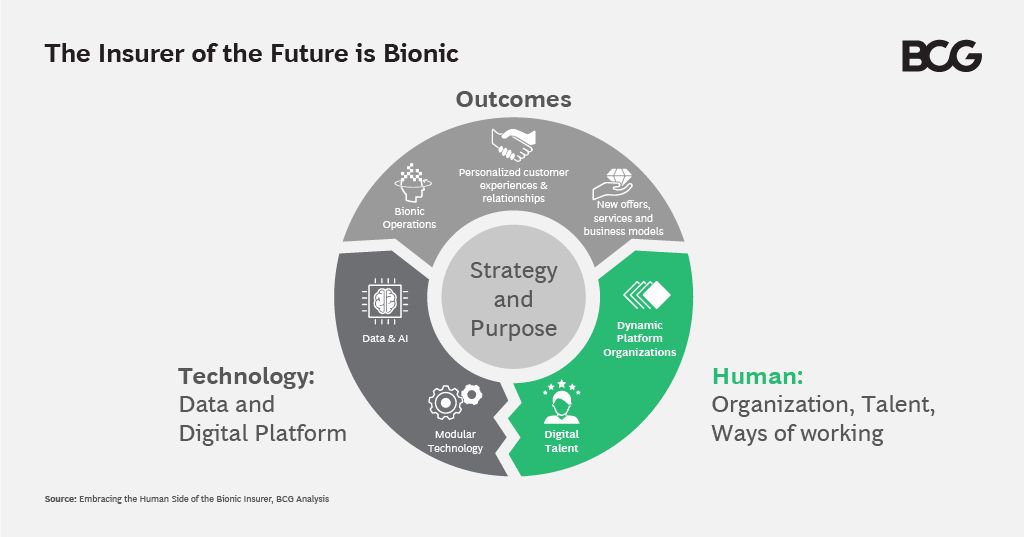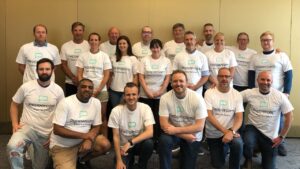By Christopher Freese, Deborah Lovich, Bodo von Hülsen, Laurent Richaud, and Michael Schachtner at BCG
Overall headcount will shrink by as much as 30%, thanks to automation and new ways of working, although staffing will expand in some areas and contract in others. We expect that approximately 20% fewer people will be needed in claims and central functions such as HR and finance as much of that work becomes automated. At the same time, up to 50% more people will work in high-value human areas such as analytics.
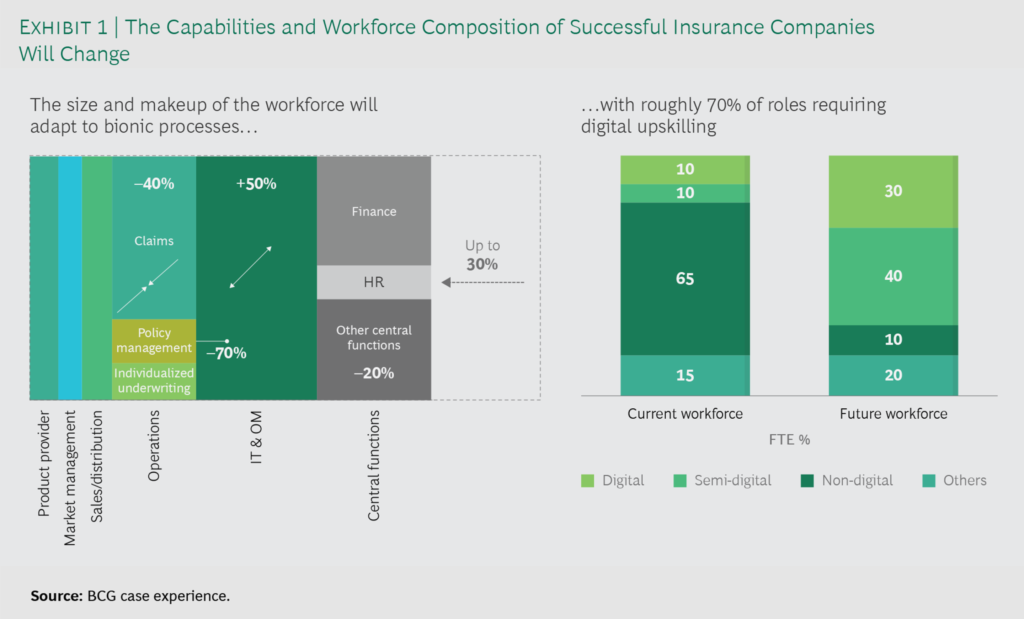
When management teams consider the implications of new bionic business models that marry humans and technology more closely than ever before, they tend to focus on the delivery and technology aspects. Too often they overlook the human changes, which are the hardest part.
According to a 2020 BCG survey of more than 5,000 employees and managers in the US, China, France, Germany, and the UK, training and recruitment of new skill profiles were the least successful elements of their company’s digital transformation. This is a big failing. As our colleagues recently pointed out in Harvard Business Review, “a digital transformation requires a talent transformation. The two go hand in hand.”
A bionic company needs a robust balance of technology and human enablers. (See Exhibit 2.) Here’s a roadmap for insurers that want to build the human bionic capabilities they’ll need. These six steps will help insurance CEOs organize the work, win the right talent, and manage their insurance company’s transformation.
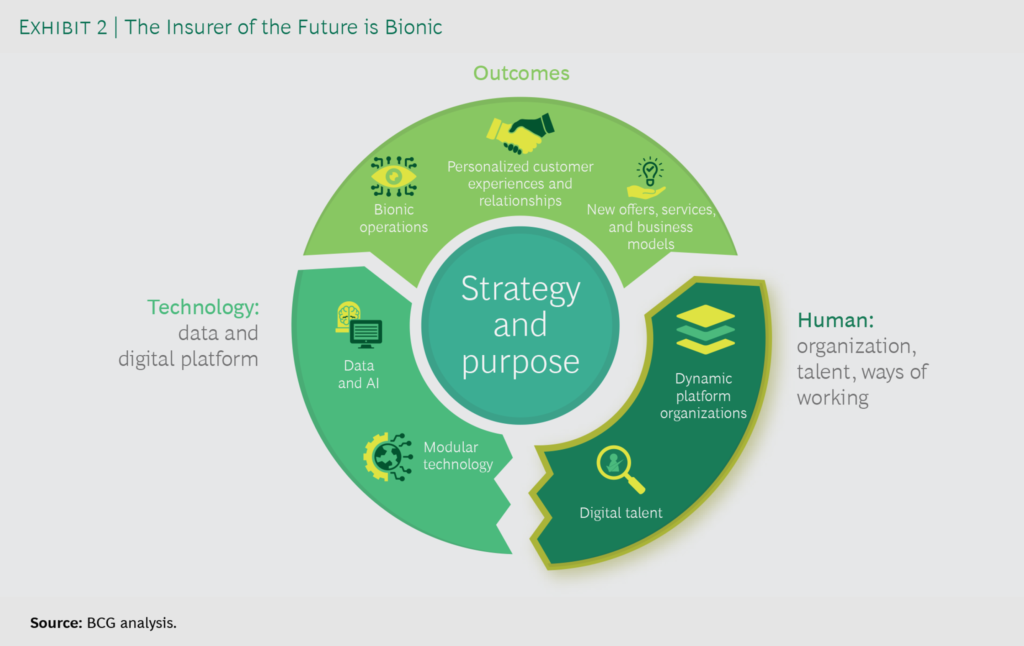
FOCUS ON CUSTOMER DELIVERY
Bionic companies organize work differently than traditional businesses do. Rather than organize around products and services, they use agile principles and ways of working to focus the organization on the customer (whether inside or outside the company) and the customer’s desired outcomes. They then use that focus to drive effectiveness and efficiency. One large US property and casualty insurer put improving its customer experience at the core of its growth strategy. The challenge was to move from an operating model anchored in product and segment to one built around the customer. The company was able to simplify and reimagine its customer engagement model and leverage its scale by aligning 3,000 people around serving customer journeys (such as customer acquisition, account servicing, and claims). For each journey, it reduced costs by 15% to 30% and improved net promoter score (NPS) satisfaction by 30 to 60 points.
EMBRACE ALIGNMENT AND AUTONOMY
A key cornerstone of an agile organization is the principle of aligned autonomy, which pushes entrepreneurship down to the levels where the action is taking place and the work is getting done. A high degree of autonomy works only when there is also a high degree of alignment in and among teams. Leaders of bionic companies ensure this alignment around overall company purpose, strategy, and priorities. They communicate their intent, explaining both the why and the what, and then let go, releasing their teams to figure out how to address their specific assigned challenge.
Autonomy requires relying on trust while simultaneously fostering transparency about results. It demands a new corporate central nervous system with KPIs rooted in values, leadership formats, and ceremonies. Embracing alignment and autonomy changes the company’s culture: the more alignment leaders are able to establish, the more autonomy they can afford to give.
ADOPT AGILE STRUCTURES AND PROCESSES
One of the most important dimensions of unleashing aligned autonomy is the future organizational structure. Plenty of companies undertake an organizational change that they label as agile, but they don’t make the kind of fundamental shifts in ways of working at scale across the organization (establishing cross-functional teams and institutionalizing a culture that regards failure as a learning experience, for example) that are the true markers of agility. A true agile-at-scale organization eliminates silos so it can focus more resources on value creation.
Plenty of companies undertake an organizational change that they label as agile, but they don’t make the kind of fundamental shifts that are the true markers of agility.
We employ what we call an agile-at-scale matrix to help management structure its thinking process for the transition to more-agile ways of working. Among other benefits, the matrix identifies scarce resources and illustrates how they can best be leveraged. (See Exhibit 3.) The matrix has four quadrants—centers of excellence, delivery units, operations teams, and customer loyalty teams—that are structured according to how complex the work is and whether it is internally or externally focused. Some current departments will move entirely into a single quadrant. Others that have activities in multiple quadrants will be split up, and the work will be organized according to the new parameters.
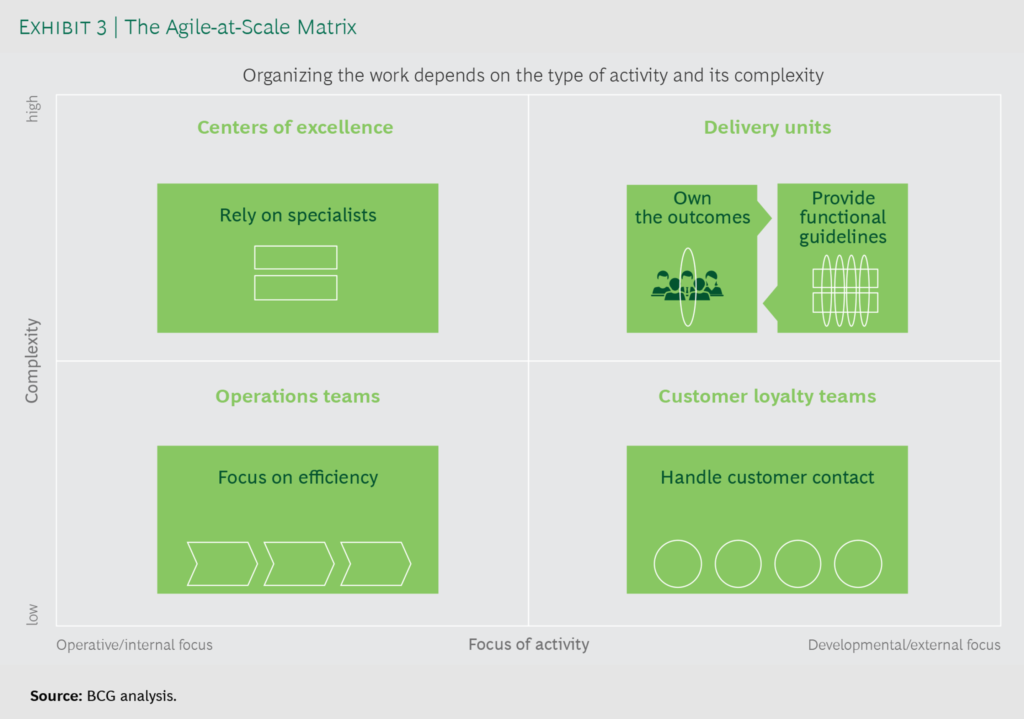
The matrix helps management scope out the transformation in waves. Structuring the organization into quadrants shows how each segment will be affected and sets a foundation for advanced strategic workforce planning. One European multiline insurer decided to focus its first wave of change on the delivery units quadrant of the matrix, which typically accounts for about 25% of staff. The company chose to leave the other quadrants untouched for the time being to avoid any disruption to running the business. In this way, the matrix can serve as the foundation for a detailed, per person-level migration to the target organization.
DEVELOP NEW TALENT
Building human capabilities at scale and staffing the bionic insurer, with its dependence on the seamless interaction between people and technology, requires a combination of strategies. Digital skills are scarce and competition for them fierce. Like companies in other industries, insurers will need to rely on bionic enablement (a combination of retraining and upskilling) as well as outsourcing in order to meet their talent requirements.
Retraining and upskilling can take several forms. One that we have used successfully with more than 50 companies is BCG’s Build-Operate-Transfer (BOT) model. Outside experts work together with internal staff and new hires to build skills while delivering digital priorities. Teams learn by doing while receiving shoulder-to-shoulder coaching. We worked with one health insurer in Europe to develop the talent it needed to harness the power of its customer data. A team of the company’s experts, our experts, and internal staff members with potential to learn worked side by side until the employees understood the intricacies of data management through a combination of coaching, reflection, and real experience.
Another approach is the digital academy and boot camp, a teaching program with two prongs. One is an academy designed to increase the productivity of existing software developers by giving them problem-solving experience, collaborative skills, depth of knowledge in modern technology stacks, speed, and creativity to meet the challenges of digital transformation. The other is a boot camp that enables new hires to excel quickly in their jobs. As with BOT, the priority of this approach is to turn over the upskilling efforts to client companies when the program is self-sustaining.
TAILOR THE APPROACH TO MEET INDIVIDUALIZED NEEDS
Few organizations have the luxury of developing their transformation plans from scratch with no constraints. In reality, agility pilots or digital initiatives may be already underway, perhaps with subcritical mass, along with pressing business issues that require short-term delivery. Ambitions and competitive strategies vary. So there is really no one blueprint for direction, priorities, or path when it comes to bionic transformation. In our work with a Japanese life insurer, we started the process with an executive alignment related to strategic ambitions and competitive differentiators. We then helped management tailor a bionic roadmap to meet its specific goals.
Digital transformations take time. A well-defined transition process will speed things up and let managers keep one eye on running the business.
Digital transformations take time, often three years or more, and companies have businesses to run and customers to keep happy while they make the transition to a new operating model. A well-defined transition process will speed things up and allow managers to keep one eye on running the business.
LEAD WITH ONE TEAM
The entire transformation process requires intensive senior management involvement and adaptation, since ways of working must change significantly (more delegation, more workshops around product development, and iteration). Many executives have to unlearn the very things that led to their personal and organizational success in the first place. That is often the toughest part of the agile transformation process for leaders. We have worked with management teams to do four key things:
- Focus on the few agile behaviors that they see as most important for themselves and their organizations
- Commit to personally acting as role models of behavioral change
- Enable and empower themselves, each other, and their teams
- Champion and celebrate new behaviors
The transformation process requires intensive senior management involvement and adaptation, since ways of working must change significantly.
Leaders must prove from the start—and continue to demonstrate—that they have embraced the program and believe it can generate value in the form of premium growth, cost reduction, or rising customer satisfaction as well as adaptability and resilience. Nothing succeeds like success, which both builds momentum and funds the journey.
In the short term, digital technologies and ways of working offer productivity improvements and better customer experiences. In the medium term, digital opens up new growth opportunities and business model innovation. In the long term, successful transformations set companies up for sustained success by propelling them strategically toward a bionic future.
Source: BCG

